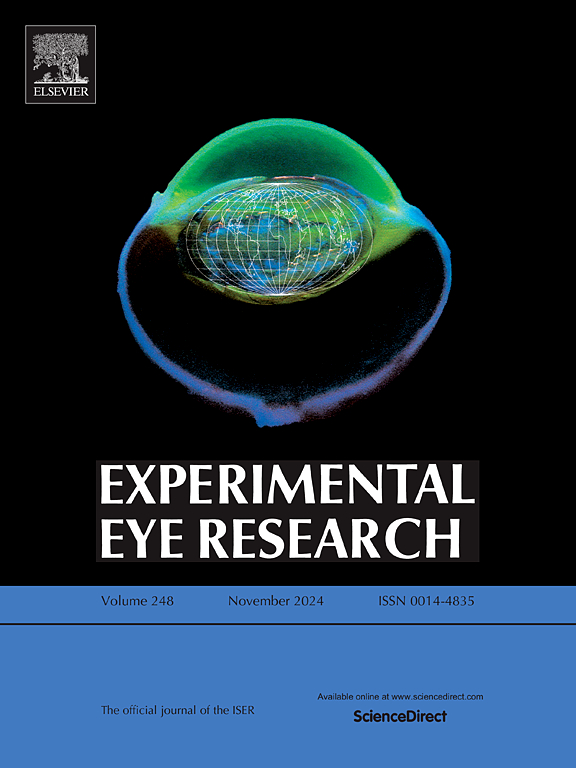A multiomic study of retinal tissues in mice with direct ocular exposure to vesicants
IF 2.7
2区 医学
Q1 OPHTHALMOLOGY
引用次数: 0
Abstract
This study employed a multiomic approach to investigate retinal tissue damage following direct ocular exposure (DOE) to vesicants (VSs)—namely, nitrogen mustard (NM) and lewisite (Lew). We explored both the acute and chronic stages of retinal injury by assessing functional, structural, and molecular changes. C57BL/6 mice were used to measure scotopic and photopic electroretinograms (ERGs) and to analyze TUNEL-positive retinal cells. Global retinal proteomics was conducted to identify common and unique signaling pathways. In addition, we performed targeted metabolomic and lipidomic analyses of retinal tissue to uncover significant metabolic changes. Our results demonstrated remarkable declines in ERG amplitudes at 2 and 4 weeks post-exposure, accompanied by an increase in TUNEL+ retinal cells in response to DOE to both VSs. Our proteomic analysis revealed chronic oxidative stress, mitochondrial dysfunction, elevated RXR signaling, and increased levels of 28 proteins. Moreover, we observed a decline in the KEGG phototransduction pathways, along with the downregulation of photoreceptor-specific proteins, in response to both VSs. Consistent with the proteomic findings, targeted metabolomics identified a decline in phototransduction and steroid hormone biosynthesis, along with increases in D-amino acid and purine metabolism, as well as lysine degradation. These changes were associated with a GSSG/GSH ratio of 2.6, confirming the proteomic data on oxidative stress. Furthermore, lipidomic analysis revealed an increase in oxidative lipid levels, accompanied by a 3.4-fold increase in phosphatidylserine (PS), suggesting apoptotic cell death and a reduction in fatty acids (FAs). In conclusion, exposure to both VSs induced progressive retinal damage, altering major metabolic pathways and dysregulating lipid metabolism. Future studies should focus on identifying the responses of individual neuronal cell types to DOE to VSs to develop cell-specific countermeasures.
直接眼接触除湿剂小鼠视网膜组织的多组学研究
本研究采用多组学方法研究眼部直接暴露于泡泡剂(VSs)(即氮芥(NM)和路易斯酸(Lew))后的视网膜组织损伤。我们通过评估功能、结构和分子变化来探讨视网膜损伤的急性和慢性阶段。采用C57BL/6小鼠测量暗位和光位视网膜电图(ERGs),分析tunel阳性视网膜细胞。通过全球视网膜蛋白质组学来识别常见和独特的信号通路。此外,我们对视网膜组织进行了有针对性的代谢组学和脂质组学分析,以发现显著的代谢变化。我们的研究结果显示,在暴露后2周和4周,ERG振幅显著下降,并伴有对两种VSs的DOE反应的TUNEL+视网膜细胞的增加。我们的蛋白质组学分析显示慢性氧化应激、线粒体功能障碍、RXR信号升高和28种蛋白质水平升高。此外,我们观察到KEGG光导通路的下降,以及光受体特异性蛋白的下调,以响应两种VSs。与蛋白质组学研究结果一致,靶向代谢组学发现光导和类固醇激素生物合成下降,d -氨基酸和嘌呤代谢以及赖氨酸降解增加。这些变化与GSSG/GSH比值为2.6相关,证实了氧化应激的蛋白质组学数据。此外,脂质组学分析显示氧化脂质水平增加,同时磷脂酰丝氨酸(PS)增加3.4倍,提示凋亡细胞死亡和脂肪酸(FAs)减少。总之,暴露于这两种VSs会导致进行性视网膜损伤,改变主要代谢途径和脂质代谢失调。未来的研究应侧重于确定单个神经元细胞类型对DOE和VSs的反应,以制定细胞特异性对策。
本文章由计算机程序翻译,如有差异,请以英文原文为准。
求助全文
约1分钟内获得全文
求助全文
来源期刊

Experimental eye research
医学-眼科学
CiteScore
6.80
自引率
5.90%
发文量
323
审稿时长
66 days
期刊介绍:
The primary goal of Experimental Eye Research is to publish original research papers on all aspects of experimental biology of the eye and ocular tissues that seek to define the mechanisms of normal function and/or disease. Studies of ocular tissues that encompass the disciplines of cell biology, developmental biology, genetics, molecular biology, physiology, biochemistry, biophysics, immunology or microbiology are most welcomed. Manuscripts that are purely clinical or in a surgical area of ophthalmology are not appropriate for submission to Experimental Eye Research and if received will be returned without review.
 求助内容:
求助内容: 应助结果提醒方式:
应助结果提醒方式:


